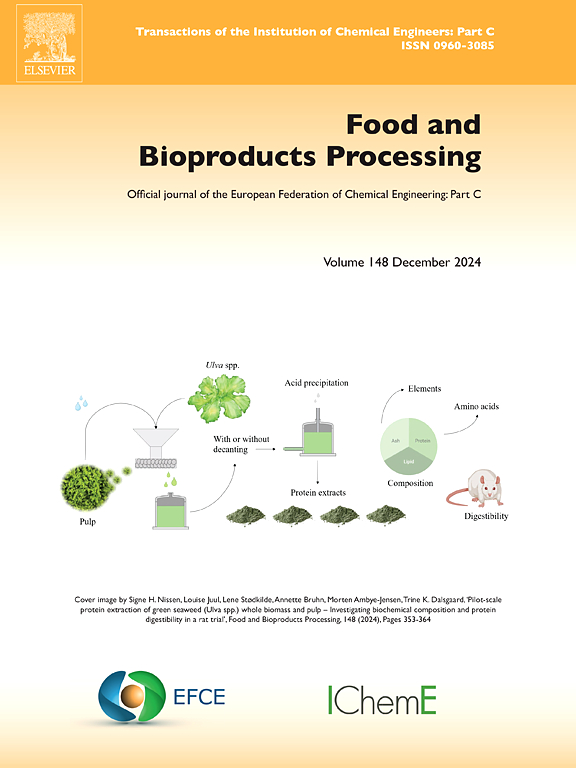Alternative industrial processing of seaweed meal from Ascophyllum nodosum: Value adding and product development potential of liquid side-streams obtained with different separation methods
IF 3.5
2区 农林科学
Q2 BIOTECHNOLOGY & APPLIED MICROBIOLOGY
引用次数: 0
Abstract
The brown algae Ascophyllum nodosum is harvested from wild sources and used in seaweed meal production. It contains multiple valuable compounds, including polyphenols, polysaccharides and carotenoids that have bioactive properties. In current uses of biomass e.g. as raw material for alginate production, these compounds are not of any special interest, hence there is an opportunity for better utilization of the biomass. Therefore, the aim of the study was to investigate the potential of producing and upscaling production of a byproduct (a targeted seaweed extract produced with mixture of fresh seaweed and water) from the unutilized liquid side-streams obtained within traditional seaweed meal processing. That was performed by evaluating the efficiency of the liquid/solid separation (screw press vs decanter), centrifugation as a secondary separation step, as well as drying methods (spray drying vs freeze drying) on the obtained liquid extracts. Chemical and antioxidant properties were evaluated throughout the alternative processing and mass balances calculated. The results suggest that the decanter was more efficient for separation compared to the screw press due to higher yield of liquid retrieved. The chemical composition and antioxidant properties did not differentiate significantly, neither between the separation methods nor during further processing of the liquids (e.g. centrifugation or drying methods). Furthermore, the alginate remained in the solid phase during separation, and main components extracted with the liquid phase included salt, minerals, polyphenols, and carbohydrates. The results indicate that alternative processing with a decanter as primary separation step could be a feasible solution to meet the demands of full utilization and no-waste policies within seaweed production.
紫苏藻粕的工业加工选择:不同分离方法获得的液侧流的附加值和产品开发潜力
褐藻 Ascophyllum nodosum 采自野生资源,用于生产海藻粉。它含有多种有价值的化合物,包括具有生物活性的多酚、多糖和类胡萝卜素。在生物质的现有用途中,例如作为生产海藻酸盐的原料,这些化合物并不特别重要,因此有机会更好地利用这些生物质。因此,本研究的目的是调查从传统海藻粉加工过程中获得的未利用液态副流中生产副产品(用新鲜海藻和水的混合物生产的定向海藻提取物)并扩大其生产规模的潜力。具体方法是评估液体/固体分离(螺旋压榨机与倾析器)、作为二次分离步骤的离心以及干燥方法(喷雾干燥与冷冻干燥)对所获液体提取物的效率。在整个替代加工过程中,对化学和抗氧化特性进行了评估,并计算了质量平衡。结果表明,与螺旋压榨机相比,滗水器的分离效率更高,因为回收的液体产量更高。无论是在不同的分离方法之间,还是在液体的进一步处理过程中(如离心或干燥方法),化学成分和抗氧化特性都没有明显的差异。此外,海藻酸盐在分离过程中仍留在固相中,液相提取的主要成分包括盐、矿物质、多酚和碳水化合物。结果表明,以滗水器作为主要分离步骤的替代加工方法是一种可行的解决方案,可满足海藻生产中充分利用和无废物政策的要求。
本文章由计算机程序翻译,如有差异,请以英文原文为准。
求助全文
约1分钟内获得全文
求助全文
来源期刊

Food and Bioproducts Processing
工程技术-工程:化工
CiteScore
9.70
自引率
4.30%
发文量
115
审稿时长
24 days
期刊介绍:
Official Journal of the European Federation of Chemical Engineering:
Part C
FBP aims to be the principal international journal for publication of high quality, original papers in the branches of engineering and science dedicated to the safe processing of biological products. It is the only journal to exploit the synergy between biotechnology, bioprocessing and food engineering.
Papers showing how research results can be used in engineering design, and accounts of experimental or theoretical research work bringing new perspectives to established principles, highlighting unsolved problems or indicating directions for future research, are particularly welcome. Contributions that deal with new developments in equipment or processes and that can be given quantitative expression are encouraged. The journal is especially interested in papers that extend the boundaries of food and bioproducts processing.
The journal has a strong emphasis on the interface between engineering and food or bioproducts. Papers that are not likely to be published are those:
• Primarily concerned with food formulation
• That use experimental design techniques to obtain response surfaces but gain little insight from them
• That are empirical and ignore established mechanistic models, e.g., empirical drying curves
• That are primarily concerned about sensory evaluation and colour
• Concern the extraction, encapsulation and/or antioxidant activity of a specific biological material without providing insight that could be applied to a similar but different material,
• Containing only chemical analyses of biological materials.
 求助内容:
求助内容: 应助结果提醒方式:
应助结果提醒方式:


